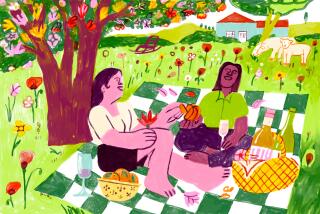Where Are They Now?
- Share via
The style was set three decades ago, before people began to fool around with winemaking.
Back then, the pioneers of the California wine industry simply picked grapes when they tasted good, crushed and fermented them, aged them in wooden vats for a bit and bottled the stuff. It wasn’t particularly high-tech, and it wasn’t much to talk about. Wherever you went in the Napa Valley, the procedure was pretty much the same.
And then the “improvements” came along. These procedures included aging the wine in new French oak barrels. Some of the resulting wines smelled and tasted more like oak than like fruit. Still, these wines are often disparaged by the new crop of wine lovers, who seek out heavier, oakier, richer, denser wines, wines that are enormous.
“Our Chardonnay doesn’t always do well in competitions,” says Mike Chelini, winemaker at Stony Hill.
That may be the understatement of the year. Stony Hill Chardonnays are lean, almost austere when young. Age has a way of making them amazingly graceful. Even decades don’t hurt them.
And so Stony Hill Chardonnay remains what its founder, Fred McCrea, wanted it to be--a delicate, perfectly crafted wine that shows little oak and ages better than most. Mayacamas, Joseph Swan and Hanzell also stick to the old formulas. Few of these wines have fat flavors; rather they are sinewy and crisp.
The most generous of the old-line Chardonnays is from Hanzell ($24), where the flavors of apple, peach and pear still pervade, yet the structure of the wine is based around strong acidity. Winemaker Bob Sessions picks grapes with more sugar than some wineries and thus gets a bit more alcohol, pushing 14%. But the acid is what holds it together.
Mayacamas Chardonnay ($20) is a bit steelier, with less flesh and a delicate fruit aroma. The wine isn’t really austere when released, but a year in the bottle softens the acidity and gives the wine breadth.
Stony Hill Chardonnay ($19) is more reticent than the others, with a delicate apple-floral quality. It changes slowly in its first few years.
All three of these wines are fermented mainly in tanks (not in barrels); they do not undergo malolactic fermentation, which softens the wine, and they are not aged in new oak barrels so they don’t have unctuous, woody tones.
Besides Chardonnay, all these firms make other wines. Stony Hill makes a small amount of Riesling and a smaller amount of Gewurztraminer (each $9). They are lean and delicate wines. The 1991 Stony Hill White Riesling is one of the most handsome wines Chelini has ever made, loaded with floral scents and elegance, its 1% residual sugar hidden by superb acidity.
Mayacamas, which gained fame in the early 1970s for massive Cabernet Sauvignons, continues to make that wine ($28) in that way--concentrated wines for long aging in the cellar.
Mayacamas also expanded its line of wines a decade ago with a sublime, delicate Sauvignon Blanc ($11) and a fairly rich Pinot Noir ($14). Mayacamas also re-releases older wines at fair prices to mailing list customers.
When Hanzell was founded, Pinot Noir was to be one of its two wines. The current Pinot Noir ($19) is not as opulent as some, but it ages beautifully for a decade or more. In the last decade Hanzell has also made a Cabernet Sauvignon ($22) with black cherry and herbal nuances and strong tannins; it requires a decade or more in the cellar.
Another of the old-line producers was Joseph Swan, a retired artist and airline pilot who opened a Sonoma County winery and named it after himself.
Swan was a perfectionist who never really sought to make large amounts of wine commercially. Now operated by his son-in-law, Rod Berglund, his firm makes wines that come largely from fruit grown on the 10-acre parcel outside the family home in the Russian River area.
Swan’s Pinot Noir ($20) is always a dark, black cherry-scented wine with anise and spice, a wine requiring time in the cellar.
Swan was a pioneer in another sense, selecting fruit for wines he felt could be special from older, far-flung vineyards. Swan’s Zinfandels ($12.50) are fruit-packed, tart and spicy wines made from Sonoma Valley vines, 20 miles south.
“Joe supported old vineyards,” says Berglund. “The saddest thing for him was to hear about an old vineyard that was going to be bulldozed. If I hear about that, I almost always offer to take the grapes. I’m a sucker for ‘em, just like Joe was.”
More to Read
Eat your way across L.A.
Get our weekly Tasting Notes newsletter for reviews, news and more.
You may occasionally receive promotional content from the Los Angeles Times.










